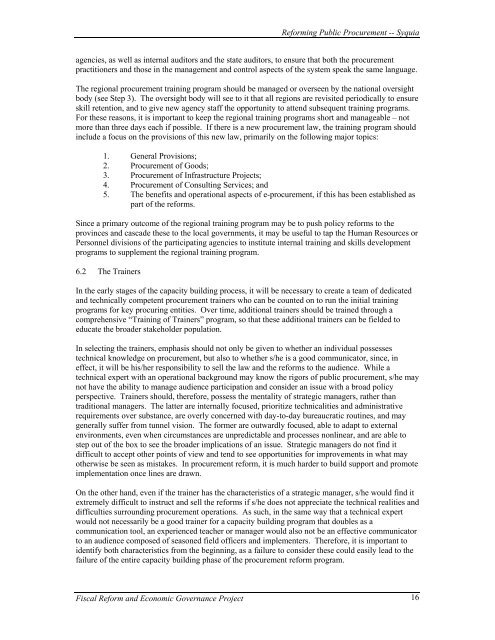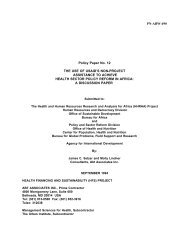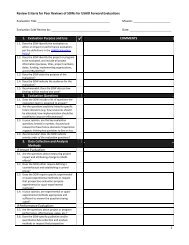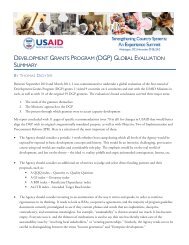Reforming Public Procurement in Emerging Market ... - KDID Portal
Reforming Public Procurement in Emerging Market ... - KDID Portal
Reforming Public Procurement in Emerging Market ... - KDID Portal
You also want an ePaper? Increase the reach of your titles
YUMPU automatically turns print PDFs into web optimized ePapers that Google loves.
<strong>Reform<strong>in</strong>g</strong> <strong>Public</strong> <strong>Procurement</strong> -- Syquia<br />
agencies, as well as <strong>in</strong>ternal auditors and the state auditors, to ensure that both the procurement<br />
practitioners and those <strong>in</strong> the management and control aspects of the system speak the same language.<br />
The regional procurement tra<strong>in</strong><strong>in</strong>g program should be managed or overseen by the national oversight<br />
body (see Step 3). The oversight body will see to it that all regions are revisited periodically to ensure<br />
skill retention, and to give new agency staff the opportunity to attend subsequent tra<strong>in</strong><strong>in</strong>g programs.<br />
For these reasons, it is important to keep the regional tra<strong>in</strong><strong>in</strong>g programs short and manageable – not<br />
more than three days each if possible. If there is a new procurement law, the tra<strong>in</strong><strong>in</strong>g program should<br />
<strong>in</strong>clude a focus on the provisions of this new law, primarily on the follow<strong>in</strong>g major topics:<br />
1. General Provisions;<br />
2. <strong>Procurement</strong> of Goods;<br />
3. <strong>Procurement</strong> of Infrastructure Projects;<br />
4. <strong>Procurement</strong> of Consult<strong>in</strong>g Services; and<br />
5. The benefits and operational aspects of e-procurement, if this has been established as<br />
part of the reforms.<br />
S<strong>in</strong>ce a primary outcome of the regional tra<strong>in</strong><strong>in</strong>g program may be to push policy reforms to the<br />
prov<strong>in</strong>ces and cascade these to the local governments, it may be useful to tap the Human Resources or<br />
Personnel divisions of the participat<strong>in</strong>g agencies to <strong>in</strong>stitute <strong>in</strong>ternal tra<strong>in</strong><strong>in</strong>g and skills development<br />
programs to supplement the regional tra<strong>in</strong><strong>in</strong>g program.<br />
6.2 The Tra<strong>in</strong>ers<br />
In the early stages of the capacity build<strong>in</strong>g process, it will be necessary to create a team of dedicated<br />
and technically competent procurement tra<strong>in</strong>ers who can be counted on to run the <strong>in</strong>itial tra<strong>in</strong><strong>in</strong>g<br />
programs for key procur<strong>in</strong>g entities. Over time, additional tra<strong>in</strong>ers should be tra<strong>in</strong>ed through a<br />
comprehensive “Tra<strong>in</strong><strong>in</strong>g of Tra<strong>in</strong>ers” program, so that these additional tra<strong>in</strong>ers can be fielded to<br />
educate the broader stakeholder population.<br />
In select<strong>in</strong>g the tra<strong>in</strong>ers, emphasis should not only be given to whether an <strong>in</strong>dividual possesses<br />
technical knowledge on procurement, but also to whether s/he is a good communicator, s<strong>in</strong>ce, <strong>in</strong><br />
effect, it will be his/her responsibility to sell the law and the reforms to the audience. While a<br />
technical expert with an operational background may know the rigors of public procurement, s/he may<br />
not have the ability to manage audience participation and consider an issue with a broad policy<br />
perspective. Tra<strong>in</strong>ers should, therefore, possess the mentality of strategic managers, rather than<br />
traditional managers. The latter are <strong>in</strong>ternally focused, prioritize technicalities and adm<strong>in</strong>istrative<br />
requirements over substance, are overly concerned with day-to-day bureaucratic rout<strong>in</strong>es, and may<br />
generally suffer from tunnel vision. The former are outwardly focused, able to adapt to external<br />
environments, even when circumstances are unpredictable and processes nonl<strong>in</strong>ear, and are able to<br />
step out of the box to see the broader implications of an issue. Strategic managers do not f<strong>in</strong>d it<br />
difficult to accept other po<strong>in</strong>ts of view and tend to see opportunities for improvements <strong>in</strong> what may<br />
otherwise be seen as mistakes. In procurement reform, it is much harder to build support and promote<br />
implementation once l<strong>in</strong>es are drawn.<br />
On the other hand, even if the tra<strong>in</strong>er has the characteristics of a strategic manager, s/he would f<strong>in</strong>d it<br />
extremely difficult to <strong>in</strong>struct and sell the reforms if s/he does not appreciate the technical realities and<br />
difficulties surround<strong>in</strong>g procurement operations. As such, <strong>in</strong> the same way that a technical expert<br />
would not necessarily be a good tra<strong>in</strong>er for a capacity build<strong>in</strong>g program that doubles as a<br />
communication tool, an experienced teacher or manager would also not be an effective communicator<br />
to an audience composed of seasoned field officers and implementers. Therefore, it is important to<br />
identify both characteristics from the beg<strong>in</strong>n<strong>in</strong>g, as a failure to consider these could easily lead to the<br />
failure of the entire capacity build<strong>in</strong>g phase of the procurement reform program.<br />
Fiscal Reform and Economic Governance Project 16







